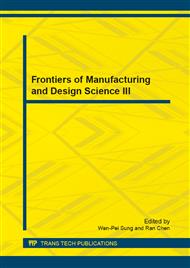[1]
Johnson W. Helicopter Theory, Princeton University Press. (1980)
Google Scholar
[2]
Elham Semsar-Kazerooni and K.Khorasani. Team Consensus for a Network Unmanned Vehicles in Presence of Actuator Faults. Transactions on control systems technology, Vol.18,No,5,(2010) pp.1155-1161.
DOI: 10.1109/tcst.2009.2032921
Google Scholar
[3]
Boškovió J D and Mehra R K. Multiple Model Adaptive Flight Control Scheme for Accommodation of Actuator Faults, AIAA Journal of Guidance, Control, and Dynamics, Vol.25, No.4,( 2002) pp.712-724.
DOI: 10.2514/2.4938
Google Scholar
[4]
Tao G, Chen S H and Joshi S M. An Adaptive Control Scheme for Systems with Unknown Actuator Faults, Automatic, Vol.38, No.6, (2001) pp.1027-1034.
DOI: 10.1016/s0005-1098(02)00018-3
Google Scholar
[5]
Chandler P, Pachter M and Mears M. System Identification for Adaptive and Reconfigurable Control, Journal of Guidance, Control, and Dynamics, Vol.18, No.3, (1995) pp.516-524
DOI: 10.2514/3.21417
Google Scholar
[6]
Zaid F A, Ioannou P, Gousman K and Rooney R. Accommodation of Faults in the F-16 Aircraft Using Adaptive Control. IEEE Control Systems Magazine, Vol.11, No.1, (1991) pp.73-78.
DOI: 10.23919/acc.1990.4790835
Google Scholar
[7]
Du X, Yang G H. An adaptive approach to state feedback tracking control of systems with actuator faults. Proceedings of the American control conference: New York, USA, (2007) pp.3997-4002.
DOI: 10.1109/acc.2007.4282391
Google Scholar
[8]
Moon G, Lee H and Kim Y. Reconfigurable Flight Control Law Based on Model Following Scheme and Parameter Estimation, AIAA Guidance, Navigation, and Control Conference and Exhibit 15-18, San Francisco, California, (2005) pp.1-12.
DOI: 10.2514/6.2005-6344
Google Scholar
[9]
Geng M, Jiang B, Guo Y Y and Yang H. Model following reconfigurable control for helicopters with actuator faults and saturation, Chinese Association of Automation Youth Conference proceedings.
Google Scholar
[10]
Bodson M, and Groszkiewicz J. Multivariable Adaptive Algorithms for Reconfigurable Flight Control, IEEE Transactions on Control Systems Technology, Vol.5, No.2, (1997) pp.217-229.
DOI: 10.1109/87.556026
Google Scholar
[11]
Bodson M and Pohlchuck W A. Command Limiting in Reconfigurable Flight Control, Journal of Guidance Control and Dynamics, Vol.21, No.4, (1998) pp.639-646.
DOI: 10.2514/2.4283
Google Scholar
[12]
Schwage M, Annaswamy A M and Lavretsky E. Adaptation-Based Reconfiguration in the Presence of Actuator Faults and Saturation, Proceedings of the American Control Conference June 8-10, Portland, USA, (2005) pp.2640-2645.
DOI: 10.1109/acc.2005.1470366
Google Scholar
[13]
Quanser, 3-DOF Helicopter Laboratory Manual. (2010)
Google Scholar


